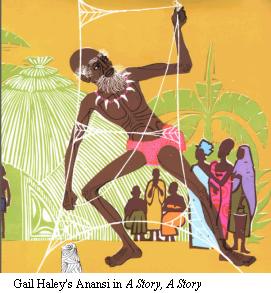Stacks challenge #2: Anansi Boys

Continuing with another sf/fantasy title, Neil Gaiman's Anansi Boys...
Thoughts while reading (at the 2/3 point):
So far this hasn't inspired the type of note-taking or examination as the Atwood, though it's been equally absorbing (and, at times, laugh-aloud funny). Mostly, I'm enjoying the way Gaiman uses legends and folklore as the basis for his tale. Gaiman also excels at intricate plots: more than one figure who initially seemed to be nothing more than a background element -- something casually introduced only to illuminate the protagonist or add color to a situation -- has instead reappeared in the most surprising situations, advancing the story.
Until Gaiman made it explicit, I'd missed the idea that Spider and Fat Charles were the same person. Now, looking back, I see similar doublings throughout the book:
- the dual nature of Anansi (which also reminded me of Gail Haley's illustrations for her account of Anansi in A Story, A Story)
- the dual nature of the other gods Fat Charlie visits -- especially through Gaiman's description of the birdwoman (which also calls up images of the Native American trickster figure Raven):
Fat Charlie saw one thing with his eyes, and he saw something else with his mind, and in the gulf between the two things, madness waited. . . .. . . while he knew that he was seeing a bird, mad-eyed, ragged-feathered, bigger than any eagle . . . its feathers the color of slate overlaid with an oilslick sheen, making a dark rainbow of purples and greens, he really only knew that for an instant, somewhere in the very back of his mind. What he saw with his eyes was a woman with raven-black hair, standing where his idea of a bird had been.
- the hidden room in Grahame Coats's office -- thus making two rooms in one (and reminiscent of Gaiman's children's books, most notably Coraline with its doubled worlds)
- Coats himself, who (at this point, anyway) has two identities he's been maintaining for some time -- one man, two names (And is his surname also an indication that one identity is a sheddable layer?)
- the cruise boat, which also has two names -- Squeak Attack, formerly Sunny Archipelago (and I still don't get that joke...)
Quick comments after finishing the book:
More doublings in the last section, especially for Grahame Coats. Is the shift in the location also a reminder that the Anansi tales travelled from Africa to other locations?
Searching for information about the book on Neil Gaiman's blog also brought up a contemporary twist in writing fiction, one that adds a wrinkle for people who like to analyze names. It's the auctioning off of naming rights for various characters. In this case, the cruise boat was christened by the winner of an eBay auction to support one of Gaiman's favorite organizations, CBDLF (which may explain why the name isn't making sense within the context of the book). (Just found Gaiman's post announcing the winner, which is apparently connected with product promotion -- and another post from him, saying this has been occurring since at least 2000. A slashdot entry provides a bit more context for the name and comments on the concept.)
Finally, since I'm linking to authors' blogs, Julius Lester, who's done some marvelous retellings of American trickster tales in his Uncle Remus series, has just started a blog.

0 Comments:
Post a Comment
<< Home